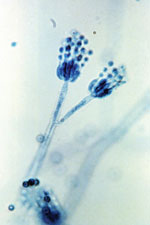Volume 25, Number 1—January 2019
Etymologia
Etymologia: Penicillin
In 1928, while studying Staphylococcus bacteria at Saint Mary’s Hospital in London, Alexander Fleming noticed that one of his petri dishes was contaminated with mold, which was causing the bacteria near it to lyse. Because the mold was identified as belonging to the genus Penicillium (Latin for “brush,” referring to the chains of conidia that resemble a paintbrush or broom), Fleming named the antibacterial substance penicillin (Figure).
Among the earliest known clinical uses of penicillin was by Cecil George Paine, a pathologist at the Sheffield Royal Infirmary, who successfully used it in 1930 to treat gonococcal conjunctivitis in neonates. Thereafter, the therapeutic potential of penicillin went largely unexplored until 1940, when a team of researchers headed by Howard Florey and Ernst Chain showed that it produced dramatic improvements in mice with streptococcal infections. Penicillin was instrumental in treating infections in Allied soldiers in World War II; however, shortly thereafter, resistance became a substantial clinical problem.
References
- Petri WA Jr. Penicillins, cephalosporins, and other β-lactam antibiotics. In: Brunton LL, Chabner BA, Knollmann BC, editors. Goodman and Gilman’s the pharmacological basis of therapeutics. 12th ed. New York: McGraw Hill; 2011. p. 1477–503.
- Wainwright M, Swan HT. C.G. Paine and the earliest surviving clinical records of penicillin therapy. Med Hist. 1986;30:42–56. DOIPubMedGoogle Scholar
Figure
Cite This ArticleOriginal Publication Date: November 14, 2018
Related Links
Table of Contents – Volume 25, Number 1—January 2019
| EID Search Options |
|---|
|
|
|
|
|
|

Please use the form below to submit correspondence to the authors or contact them at the following address:
Ronnie Henry, Centers for Disease Control and Prevention, 1600 Clifton Rd NE, Mailstop E28, Atlanta, GA 30329-4027, USA
Top